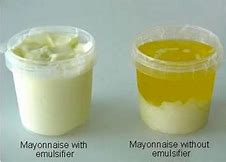ChatGPT said: Frequently used types of emulsifiers and where they are applied
The Crucial Advantages of Emulsifiers for Smooth and Secure Mixtures
Emulsifiers are important in producing smooth and steady blends across numerous industries. They minimize surface stress in between immiscible liquids, leading to enhanced appearance and general sensory experiences. In food and cosmetics, their duty prolongs past plain blending; they likewise boost life span and product integrity. Recognizing the types and applications of emulsifiers exposes their significance in formulation procedures. However, the subtleties of their efficiency warrant better exploration.
Recognizing Emulsifiers: The Science Behind the Blend
Although emulsifiers are typically forgotten in day-to-day food preparation and food manufacturing, they play an important role in stabilizing blends that would otherwise divide. Emulsifiers are substances that reduce surface area stress in between 2 immiscible liquids, such as oil and water. They possess both hydrophilic (water-attracting) and hydrophobic (water-repelling) buildings, permitting them to communicate with both phases. This distinct characteristic enables emulsifiers to create a steady interface, preventing the splitting up of fats and fluids.
Typical instances of emulsifiers consist of lecithin, frequently originated from eggs or soybeans, and mono- and diglycerides. These materials develop a consistent texture in products like mayonnaise, salad dressings, and sauces. The science behind emulsifiers hinges on their ability to develop a steady emulsion, which is essential for accomplishing desirable food high quality and life span. Understanding the feature of emulsifiers is crucial for food researchers and cooking professionals going for constant outcomes.
Culinary Applications: Enhancing Flavor and Structure
Emulsifiers significantly boost culinary applications by boosting both flavor and structure in a selection of food items (emulsifiers). They play a necessary role in developing secure emulsions, which are important for sauces, dressings, and mayonnaise. By enabling the even circulation of fats and water, emulsifiers assure that flavors are well-blended and unified, improving the total taste experience
In baked products, emulsifiers contribute to a better crumb structure and enhanced dampness retention, resulting in items that are soft and enticing. Furthermore, they help extend life span by stopping splitting up and preserving freshness.
In milk items, emulsifiers aid in producing smooth appearances, crucial for products like ice cream and lotion cheese, where mouthfeel substantially impacts consumer satisfaction. Overall, using emulsifiers in cooking applications not only elevates taste profiles yet likewise improves the sensory experience of different food products, making them a lot more enticing and pleasurable.

Aesthetic Utilizes: Creating Glamorous Formulations
When formulating cosmetic products, the inclusion of emulsifiers is crucial for achieving smooth and luxurious appearances. These representatives assist in the blending of water and oil phases, developing secure solutions that enhance item efficiency and user experience. Emulsifiers not just enhance the uniformity of creams and creams yet also contribute to the general sensory attributes, allowing for a much more positive application and feel on the skin.
Furthermore, emulsifiers play an essential duty in the efficient delivery of active components, making sure that they remain uniformly dispersed throughout the solution. This consistent distribution enhances the item's efficiency, supplying targeted advantages such as hydration, anti-aging, and defense. The ideal emulsifier can present a wanted thickness, protecting against splitting up and preserving product stability over time. Ultimately, emulsifiers are important in creating high-grade cosmetic formulas that meet consumer assumptions for luxury and efficiency.
Kinds of Emulsifiers: Natural vs. Synthetic
Understanding the differences in between natural and synthetic emulsifiers is crucial for formulators intending to enhance aesthetic products. All-natural emulsifiers, stemmed from plant or animal resources, consist of ingredients like lecithin, beeswax, and different gum tissues. They are frequently preferred for their skin-friendly residential or commercial properties and biodegradability. Furthermore, they can boost the sensory profile of formulations, supplying a more enticing texture and feel.
On the other hand, synthetic emulsifiers are chemically crafted to produce specific capabilities and security. Common examples include polysorbates and stearic acid. These emulsifiers generally provide premium performance pertaining to emulsification efficiency and shelf-life stability. Nonetheless, they might increase problems relating to skin sensitivity and ecological effect.
Inevitably, the choice in between all-natural and artificial emulsifiers depends upon the wanted product features, formulation objectives, and customer preferences, highlighting the importance of recognizing their distinct residential or commercial properties. emulsifiers.
The Duty of Emulsifiers in Food Preservation

Tips for Making Use Of Emulsifiers Successfully in Recipes and Products
When utilizing emulsifiers in recipes and products, selecting the appropriate type Website is necessary for attaining desired outcomes. Additionally, utilizing proper mixing methods can greatly enhance the stability of emulsified combinations. Finally, understanding storage methods and life span ensures the durability and performance of these emulsifiers.
Choosing the Right Emulsifier

Selecting the proper emulsifier can considerably boost the structure and stability of a combination, as the ideal option relies on the particular active ingredients and desired result. Numerous factors influence this decision, consisting of the sort of oils or fats, the existence of water, and the target uniformity. Lecithin is suitable for dressings and sauces, while xanthan gum functions well in gluten-free baking. Additionally, the emulsifier's compatibility with various other ingredients plays a substantial duty in attaining the desired stability. It is necessary to consider the temperature variety of the application, as some emulsifiers perform much better under particular conditions. Eventually, comprehending the qualities of each emulsifier will certainly result in much more reliable formulation in products and recipes.
Appropriate Mixing Techniques
Utilizing efficient blending methods is essential for accomplishing optimal emulsification in products and recipes. Initially, it is necessary to introduce emulsifiers gradually, enabling them to distribute uniformly throughout the mixture. High-shear mixing approaches, such as utilizing an additional resources immersion or a blender or food processor mixer, can enhance emulsifier efficiency by breaking down fat globules. Keeping a constant temperature during blending likewise aids in accomplishing a stable solution, as fats and fluids can blend better when warmed up. Furthermore, including components in the proper order-- beginning with the liquid stage complied with by the fat stage-- makes sure even distribution. Lastly, mixing must continue up until the preferred consistency is reached, avoiding over-mixing, which can lead to splitting up. Appropriate strategies eventually lead to smoother, much more secure solutions.
Storage Space and Life Span
Although the performance of emulsifiers can significantly boost the top quality of mixtures, correct storage space and interest to life span are essential for preserving visit this site their efficiency. Emulsifiers should be saved in an awesome, dry setting, far from direct sunshine and dampness, which can weaken their properties. It is suggested to keep them in impermeable containers to avoid contamination and oxidation. Furthermore, checking the expiration dates and adhering to recommended storage guidelines can maximize their performance. Regular assessments of texture and stability in mixes can indicate whether the emulsifier is still working properly. By adhering to these storage space practices, users can guarantee that their emulsifiers stay powerful, causing consistently smooth and steady combinations in items and recipes.
Regularly Asked Questions
Are Emulsifiers Safe for People With Dietary Restrictions?
Emulsifiers can be risk-free for people with dietary restrictions, depending on their source and composition. It's important for those with allergies or specific nutritional needs to very carefully assess ingredient labels and consult with healthcare experts.
Just How Do Emulsifiers Impact the Service Life of Products?
Emulsifiers enhance the service life of products by maintaining mixes, protecting against splitting up, and decreasing wasting. Their capacity to keep harmony aids guarantee durability, eventually protecting taste, structure, and general high quality in different food products.
Can I Make Emulsifiers in your home?
Yes, self-made emulsifiers can be produced utilizing natural active ingredients like egg yolks, mustard, or honey. These choices can assist blend oil and water, however results may vary based upon the particular recipe and technique utilized.
What Are Usual Emulsifier Allergies to Expect?
Usual emulsifier allergic reactions consist of responses to soy lecithin, egg yolk, and dairy-based emulsifiers. People with level of sensitivities might experience signs like hives, intestinal distress, or breathing issues upon exposure to these active ingredients in numerous foodstuff.
Just How Do Emulsifiers Impact Nutritional Value?
Emulsifiers can affect nutritional value by improving vitamins and mineral absorption and bioavailability - emulsifiers. Nevertheless, excessive usage may result in vitamins and mineral loss or imbalance, possibly impacting health end results, especially in refined foods where they are prevalent
Emulsifiers greatly improve culinary applications by enhancing both taste and appearance in a selection of food products. In milk products, emulsifiers help in creating smooth appearances, essential for products like ice cream and lotion cheese, where mouthfeel considerably influences customer satisfaction. In the domain of food conservation, emulsifiers play a considerable duty in preserving the high quality and shelf-life of numerous products. In products like salad dressings and sauces, emulsifiers aid to maintain appearance and taste security over time, guaranteeing that the food stays enticing to customers. Typical emulsifier allergies consist of reactions to soy lecithin, egg yolk, and dairy-based emulsifiers.